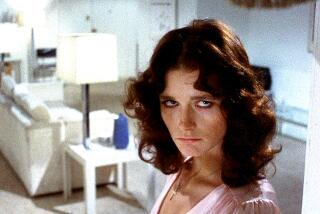MOVIE REVIEW : âExposureâ Settles for Less Than Tantalizing Potential
There may be something unconsciously premonitory about the fact that the people whoâve made a movie out of Rubem Fonsecaâs fascinating Brazilian thriller âHigh Artâ have changed its title to âExposureâ (Laemmleâs Fine Arts). Are these filmmakers--at least the ones doing the English-language version--as leery of the word art as the average American studio executive?
There is exposure in the movie: murdered prostitutes, nudity, three-way sex, the unveiling of Brazilâs cocaine cartels. And some art. The frames are succulently composed; the Brazilian and Bolivian backgrounds offbeat and spectacular; the dialogue--by novelist-screenwriter Fonseca and âEnglish versionâ writer Matthew Chapman--spare and enigmatic. The core cast--Peter Coyote, Tcheky Karyo, Amanda Pays and the others--is many cuts above the norm.
But something doesnât jell.
âExposureâ is full of violence--but itâs aestheticized bloodshed. In the film, Coyoteâs saturnine photographer, named Mandrake (probably after the comic-strip magician), attempts to solve and avenge the death of a young Rio prostitute. Revenge spurs him on. He becomes an expert âPersevâ (for âperforate and severâ) knife fighter, under the tutelage of the mysterious Hermes (Karyo of âLa Femme Nikitaâ) and takes on the cocaine cartel itself: a band of villainous gargoyles, swilling in elegance, sunk in a Byzantine tangle of betrayal.
Unlike Fonsecaâs novel, the film lacks a certain fantastic filigree. Itâs been stripped down into a modern Samurai saga, like one of the â60s French gangster films of Jean-Pierre Melville, but it doesnât have Melvilleâs chilly austerity or control. Someone has decided to add a narration, by Angst -ridden Mandrake, to this picture, and it often uncomfortably resembles those 1982 âBlade Runnerâ voice-overs. We donât need it--though we could use a lot more of the bookâs dense plot, inside jokes, twists and turns.
âExposure,â by turning Coyoteâs Mandrake from a lawyer into a photographer, also tries to become another âBlow-Upâ-style movie meditation on the artistâs struggle between passivity and activism. Mandrake, who gets sucked out of his voyeurism into a maelstrom of carnage, ends up wielding knives instead of Nikons and, in the book, his quest is a little absurd.
Just as the novel was a burlesque roman noir, âExposureâ is a parody film noir , with Hitchcock and Polanski the most obvious influences. But perhaps parody isnât the right word; thereâs not much comic gusto in the filmâs mimicry. The director, Walter Salles Jr., composes his scenes as if he had an objet dâart complex--and, midway through, the narrative line seems to snap apart. The deadly irony of the bookâs ending is replaced with a climax that slides uneasily from sadism to sentimentality. The movie, impressive in pieces, lacks rhythm as a whole. Its high-tech, high-shock elements bury the theme.
Still, misfires like âExposureâ (MPAA rated R, probably for sex, nudity, language and violence) are more interesting than the usual misfires: the ones desperately trying and failing to repeat the mediocre. This movie really should have been âThe Maltese Falconâ cubed. Instead, it comes off more like âHigh Artâ diced: chunks of high talent bobbing in a stew of blood and aphorisms.
âExposureâ
Peter Coyote: Peter Mandrake
Tcheky Karyo: Hermes
Amanda Pays: Marie
Raul Cortez: Lima Prado
A Miramax release. Director Walter Salles Jr. Producer Alberto Flaksman. Executive producer Paulo Carlos de Brito. Screenplay by Rubem Fonseca. Cinematographer Jose Roberto Eliezer. Editor Isabelle Rathery. Costumes Mari Stockler. Music Jurgen Knieper, Todd Boekelheide. Production design Nico Faria, Beto Cavalcanti. Knife Fighting Coach Christopher Kent. Running time: 1 hour, 45 minutes.
MPAA-rated R
More to Read
Only good movies
Get the Indie Focus newsletter, Mark Olsen's weekly guide to the world of cinema.
You may occasionally receive promotional content from the Los Angeles Times.










